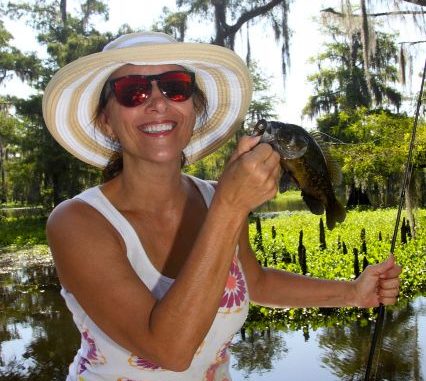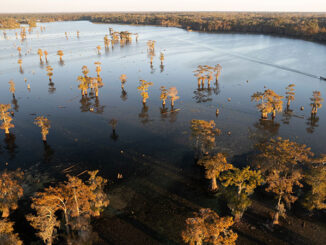
When the weather starts warming this month, it’s time to head to the lower Atchafalaya Basin for the beginning of the panfish season. Here’s how to pick up some chinquapin and other bream for the table.
“Grandchildren are the dots that connect the lines from generation to generation,” according to Lois Wyse.
Certainly, when any of my grandchildren want to spend time fishing with me that’s a connection I want to make.
And it’s something that makes me and them full to the bream — chinquapins and bluegills, that is — and the lower Atchafalaya Basin is just the place to reconnect come April.
My granddaughter Lillie bugged her dad about going fishing, and he referred her to me with a guarantee.
“Papa knows where the fish are,” he promised.
The fact of the matter was that he left off the part about how it all depends.
Sure, I have a couple of easy-to-get-to favorite spring Basin spots — locations that seldom fail me and my spouse.
Additionally, when the conditions are right, redear sunfish (aka chinquapins and shell crackers) are pretty easy to catch in those honey holes of ours.
In fact, most small children could catch them with a Snoopy fishing pole.
My granddaughter, who happens to be in her early 20s, isn’t a child anymore, but you couldn’t prove it by her excitement when we made plans to make a trip to the Basin last spring.
The weather conditions had warmed up, the water temperatures were finally conducive for the spawn to begin, and the concentration of redear sunfish and bluegills over the past several years had never been better.
While I was confident, I like to think there is more of an art to fishing bream than that — and others do, too.
“It’s all trial and error of course,” Patterson’s Gerald Foulcard said. “But I like to fish a blue-and-white Creme tube jig with a little piece of grass shrimp on the hook under a cork. I’ll set the jig at the 1 to 1 ½ foot depth and shake it.
“Occasionally, you’ll have to go a little shallower, and other times you’ll have to go a little deeper.”
One of the tricks Foulcard uses for chinquapins is bouncing his jig right off the bottom without a cork. He also mentioned he’ll use a beetle spin rigged with black-and-chartreuse, blue-and-white, black-and-pink or red plastics along the bottom.
“I also use Becky’s hair jigs,” Foulcard said. “All of these artificial baits will coax fish into biting. I’ll slow-roll the beetle spin deep or I’ll bounce the jig off the bottom.
“Generally, when I use either of these tactics for bream its bam, and it’s on.”
On our trip, we were going to use live bait, and my granddaughter was game when it came to the worms.
She got past the wiggles and sticky slime of the invertebrates, impaling them onto the No. 6 Aberdeen hook I set her up with as she mustered up confidence.
“I can do this,” she told herself.
Once the deed was done, she cast the rig toward the outside edge of some submerged vegetation with fairly decent accuracy.
And her balsa cork sank beneath the water’s surface.
Her first fish of the day was nothing more than a small bait-stealing bluegill — on my boat, I impose a 7-inch minimum length.
Her Nana tried to convince me it was a keeper, and somehow the fish made its way into the ice chest despite my grumblings.
Lillie quickly cast her rig right back near the grass — confident she had lowered Papa’s bar to 6 ½ inches.
Some of the best chinquapin fishing in the lower Atchafalaya Basin occurs near Adam’s Landing in the Shell oil-field canals in the spillway.
Additionally, Flat Lake and Bear Bayou can be excellent, although the bite seems to always turn on the latter part of April.
Mrs. Flores and I always make our first spring freshwater fishing excursion to this particular area, fishing along the tree edges in the northern part of the lake, before heading into Bear Bayou.
We fish the base of trees, sloughs that drain into the main bayous, and any and all deadfalls we see. Clear to slightly stained water seems to be most productive for us.
And when the water is falling in the Basin the fishing can be special.
Fishing in April isn’t like fishing in late May and June — during the April bite you pretty much can catch fish all day. We’ve even found we were too early for the morning bite.
It’s later in the spring and summer, when temperatures reach into the high 80s and low 90s some days, when we start thinking morning and evening bite.
On this trip, my granddaughter’s biggest thrill might have come from the hard-hitting smack and then pull of a goggle-eye that we seemed to get into on our Basin trip.
I was doing my best to make good on his son’s guarantee, and I knew I’d score high marks when this chubby bruiser got into the boat — she’d just have to do her part and reel it in.
My wife and I always boat a few goggle-eye during our April excursions. Their huge, red eyes give them a ferocious look and their dark colors hide them quite well beneath the water where they lurk, hiding to ambush prey.
The chunky fish always provide good tussles, and they make great table fare.
Moreover, it just wouldn’t be a basin trip if one or two didn’t make it into the ice chest.
